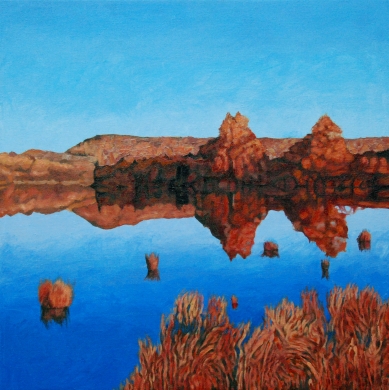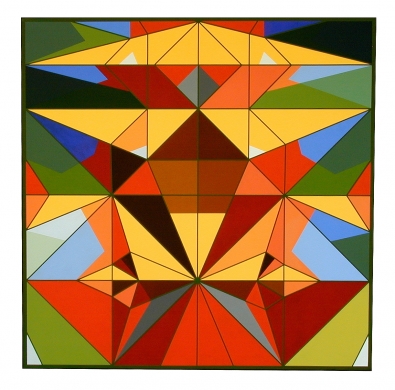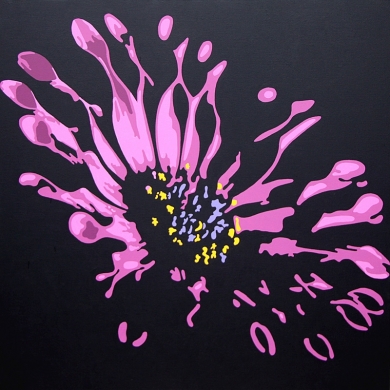When it comes to fine arts painting, most artists tend to use one of two types of paint: oil or acrylic. Comparing the two, oils have tradition on their side, but acrylics offer many advantages, such as fast drying time, and bright, vibrant colors.
Acrylic paint tends to be opaque versus transparent, and it can sometimes look flat on the canvas. However, there are many additives and techniques that artists can use with acrylics to achieve various degrees of transparency, making it possible to create effects that are very similar to oil or even watercolor painting.
Artist acrylics have only been on the market since the late 1940s, and were first developed by Sam Golden of Golden Artist Colors. The Liquitex Company followed with the invention of the first water-based acrylics in 1955. These two companies remain among the most popular and successful distributors of acrylics today.
As with artist preference, most art collectors have a preference as to what type of paintings they like to buy. There are some purists who believe that regardless of subject matter or provenance, oil paintings are always more desirable than acrylic. It’s true that oil paints have been around for a lot longer than acrylics and have had more time to establish a reputation, but many in the art industry believe that in the right hands, one medium is just as good as another. In the end, it all boils down to personal taste.
Many prominent artists of the past have chosen acrylics as their medium of choice. Modern masters like Mark Rothko and Andy Warhol created works of great depth and lasting impact using acrylics. So, the next time you are in a museum – or browsing Zatista for the perfect piece for your own home gallery – don’t judge a painting by its materials. Just say yes to acrylics!
Brian Sylvester is a guest blogger on WallSpin, and an artist on Zatista.
Related articles
- 10 Ways to Make a New St(ART) (zatista.com)
- A Walk in the Park (zatista.com)








I’m surprised no one has commented on this yet, and
I guess your post is aimed at a general audience of novice art appreciators. But to me, it belies your lack of acquaintance with oil paint as a substance and with contemporary art history.
(A disclaimer – oil is my medium of choice for many reasons).
First, saying that quick drying time, vibrant colors and a uniformity of surface are selling points for a paint is a pretty weak case. Unless you want to cater to short attention spans and a proclivity for bright shiny objects. In fact, it’s pretty revealing that there have been so many additives formulated for people to add to acrylic paint in order for it to achieve the range of what oil paint can do in experienced hands.
Working with oil paint is a multi-course meal that allows for an ongoing dialogue with the actual substance, a challenge both physical and mental for the artist to understand the properties of each pigment as it is altered by being ground with oil, and a more compelling give and take with technique. Even when working quickly. It demands more from the artist.
Acrylic feels like fast food. Sure you can make a picture quickly. But too often, I come upon paintings done in acrylic paint that feel as if you could just peel them off the canvas.
It’s true that either one handled badly is bad, but oil handled with mastery will always win in my book.
Now to the reason I really wanted to respond- your claim that Mark Rothko is a shining example of how great contemporary work has been done by artists using acrylic paint.
I almost choked! Throughout his entire career Rothko was using oil paint (and other interesting additives) to create layers and surfaces that were subtle, glowing, varied and allowed the materiality of his brushstrokes to react to the light. (I would really recommend the catalog the National Gallery put out for the Rothko exhibit I was lucky to see at the Whitney in ’98)
It was only in the last year of his life, when his health was seriously diminished, and his doctors advised him to stop painting large, that he turned to acrylic to make some paintings on paper. Then, there is Andy Warhol, who was primarily having assistants creating images using silkscreening techniques, not painting with a brush in his hand using acrylic.
Just wanted to clear up some facts for the readers.
Nanci, thank you for pointing out those facts.
Oil paint is also the medium I prefer. I was surprised to open the Zatista wall spin email and see my mixed media painting of a telephone. I appreciate Zatista using this work as an example, but I also greatly appreciate your corrections to the article that accompanies the image.
– All the best, Alice Flynn
Thanks Nanci and Alice for your comments and clarifications. In citing Rothko and Warhol I was trying to use recognizable names with generally good reputations in the serious art world to make the point that acrylics are not only for hobbyists, amateurs and unknowns, and that it is the effect of the final product on the viewer, not the materials used, that truly matters in matters of art appreciation. Wall Spin is indeed a small format designed for general readership and not meant as the final word in art history or opinion, and I always welcome any feedback from readers.
I also appreciate Nanci’s clarifications – accuracy is a good thing.
Maybe an actual follow-up post would be good, highlighting some artists for whom acrylics are (or were) their first choice, and clarifying that Rothko didn’t choose or endorse acrylics over oils. The more accurate information is languishing here with a link that is almost hidden, while the misleading post is front and center.
I was also a bit stunned when I opened this post in my email box.
To amend the public record, it should be noted that Mark Rothko was using acrylic paints as early as 1947. One such work is owned by the San Francisco Museum of Art: Mark Rothko, Untitled, 1947; acrylic and oil on canvas, 48 1/8 in. x 40 1/8 in. (122.24 cm x 101.92 cm); Collection SFMOMA, © 1998 Kate Rothko Prizel & Christopher Rothko / Artists Rights Society (ARS), New York
Source: http://www.sfmoma.org/explore/collection/artwork/4900#ixzz3VDWQqHRh
San Francisco Museum of Modern Art